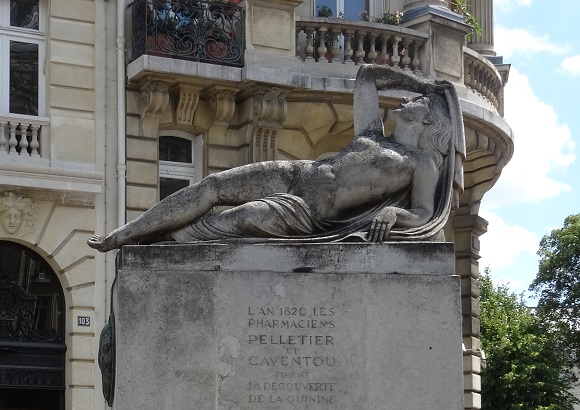
Part 2 of an article about hospital and medical heritage in Paris, including Louis Pasteur, Marie and Pierre Curie, military medicine and George Orwell. (Return to Part 1.)
The Pasteur Museum: Pasteurization, vaccination and a beautiful crypt
Public health was on the upswing in the late 19th century in part thanks to the work of Louis Pasteur (1822-1895). The Pasteur Museum and Institute, in the 15th arrondissement, is a reminder of the positive effects of the famous scientist’s work on our daily lives. And Pasteur himself is buried in the basement in one of Paris’s most beautiful crypts.
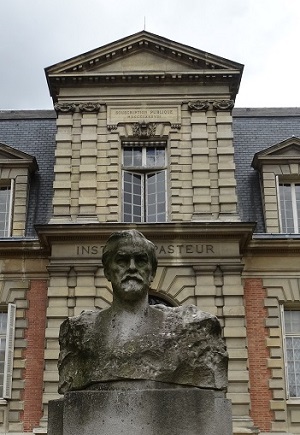
It’s rare to have a scientist’s name given to a method rather than to an object or measurement, but pasteurization—partial sterilization enabling the demise of undesirable organisms—is known throughout the world. Beyond the reliable dairy products so associated with pasteurization, each time we lift a glass a beer or wine we can toast the great chemist. In fact, Pasteur discovered the benefit of heating wine before the benefit of heating milk when Napoleon III was looking to keep the wine sent to his soldiers from going bad. We can also pet the neighbor’s dog in peace thanks to Pasteur’s work in developing a vaccine for rabies.
Pasteur’s professional work as a chemist who came to practice biology had enormous implications on hygiene and medicine, and the institute that bears his name continues to work throughout the world to create vaccines and to eradicate disease.
The Pasteur Museum is an excellent introduction into his life and scientific times. It is part exhibition about his scientific accomplishments and discoveries through original instruments (explanations available in English), part tour of his apartment within the original building of the Pasteur Foundation. Ten pastels portraits that he drew between the ages of 13 and 20, hanging in his bedroom and in the dining room, unexpectedly reveal Pasteur to be an admirable visual artist before he turned to science. Being able to draw what one saw under the microscope was nevertheless an important skill for a 19th-century scientist.
The unexpected pleasure of a visit here is the chance to descend into the beautiful crypt where he and his wife are buried. For cryptophiles it alone is worth a visit to the Pasteur Museum. Inspired by the 5th-century Mausoleum of Galla Placidia in Ravenna, Italy, the neo-Byzantine curves and remarkable mosaics form an ensemble that one would more likely associate with nobility or with a saint. Pasteur’s dark green granite tomb occupies the center of the crypt. His wife, who died 15 years after Pasteur, is buried by the altar.
The original building of the Pasteur Foundation, in which the museum is located, is part of the vast complex of the Pasteur Institute which includes departments for research, education and vaccination. The original foundation building was funded by “national subscription,” a form of crowdfunding at the time. The Pasteur Institute is a private institution. Nearly half of the Pasteur Institute’s budget comes from income from its own activities, just over one quarter is subsidized by the State and about a quarter comes from donations and real estate assets.
Pasteur didn’t travel much, but he asked his students to deal with local health and hygiene problems wherever they may go, leading to what has been called “scientific evangelization” as his work and emphasis on the scientific method spread around the world. In addition to the Paris headquarters, there are 32 Pasteur Institutes around the world, employing 2400 people in more than 60 countries.
Pasteur left behind a detailed trace of his actions and methods in studies, letters and other documents. Due to the importance and extent of his work, the Pasteur archives have recently been listed in UNESCO’s International World Register of the Memory of the World. Those archives are maintained and have been digitized by the Academy of Sciences and the National Library of France.
Musée Pasteur / Institut Pasteur, 25 rue du Docteur Roux, 15th arrondissement. Metro Pasteur. Open Mon.-Fri. except for holiday and August. Visits at 2pm, 3pm and 4pm, without reservation for individuals. Visitors must show ID to enter the Institut Pasteur complex in which the museum is located. Adults: 7 €. Students and children: 3€. Reservations required for groups.
Musée Curie and the treatment of cancer
The free little museum at the Curie Institute (5th arrondissement) provides an introduction to radioactivity, radiation therapy and the life of double Nobel Prize winner Marie Curie (1867-1934) and her husband Pierre (1859-1906), with whom she shared her first Nobel.
Born Maria Sklodowska in Warsaw, Marie arrived in Paris in 1891 to continue scientific studies that she had begun in Poland. She married the French scientist Pierre Curie in 1895. Together the Curies discovered radioactivity through polonium and radium. They shared the Nobel Prize for physics in 1903 with Henri Bequerel for their research into radiation. Marie thus became the first woman to receive the Nobel. Pierre’s life was cut short in 1906 when he was run over by a horse-drawn carriage. In 1909 the University of Paris and the Pasteur Institute joined forces to create the Radium Institute with her at the helm. She later received a second Nobel for chemistry for her work into polonium and radium, making the first double winner, man or woman, in different fields.
Once the scythe of WWI and the flu pandemic of 1918 had passed and the work of Pasteur and others had paved the way for improved and increasingly extensive vaccination, cancer was recognized as a major killer in France. While the virtues of radium therapy had been known since the early 1900s, channeling it for therapeutic value remained a work in progress. The Curie Foundation, which opened in 1922, became the first center in France devoted to fighting cancer with radiation therapy.
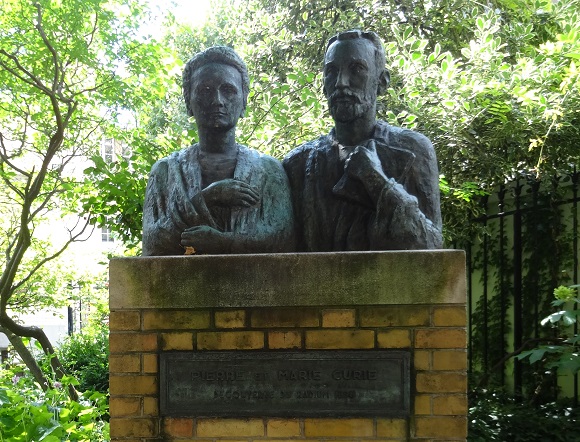
Marie Curie died of leukemia in 1934. The following year the Curie’s daughter and son-in-law also received the Nobel in chemistry for their discovery of artificial radioactivity.
The Radium Institute and the Curie Foundation merged in 1970 to form the Curie Institute. This little museum occupies the ground floor of the building where Marie had her office, which can be seen as she knew it. Research, education and cancer treatment are the institute’s aims. About 50% of its research funds come from the State, while medical insurance covers 100% of medical care provided by the institute.
In 1995, the ashes of Pierre and Marie Curie were transferred to the Pantheon, just around the corner from her office and from the museum. She thus became the first woman to enter the Pantheon for her own achievements.
Musée Curie, 1 rue Pierre et Marie Curie, 5th arrondissement. RER Luxembourg. Open Wed.-Sat. 1-5pm. Closed holidays and August and for two weeks late December-early January. Entrance is free, while donations are welcome.
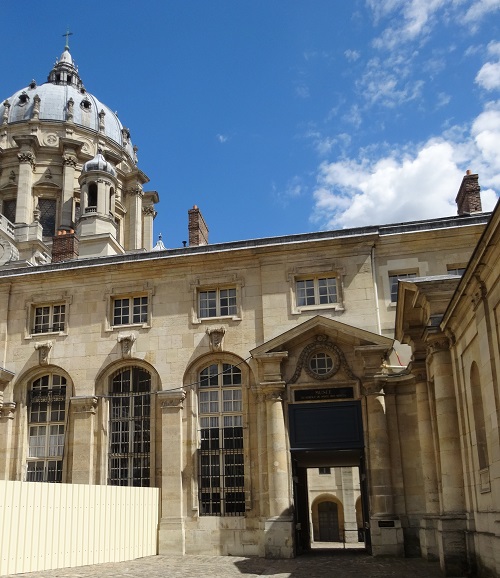
Val de Grâce and the Museum of Health Service of the Armed Forces
In 1670, 14 years after decreeing the creation of the “general hospital” of La Salpêtrière, Louis XIV decreed the construction of a royal “hostel” to lodge officers and soldiers who were disabled, old or obsolete: Les Invalides. More than 6,000 men were admitted at Les Invalides between 1676 and 1690.
One visits the complex now as the Army Museum and as the site of Napoleon’s tomb beneath the great dome, yet portions of the Hôtel National des Invalides still provide medical services for veterans.
But it’s at Val de Grâce, the military and teaching hospital the 5th arrondissement, where you’ll find the Museum of Health Service of the Armed Forces (Musée du Service de Santé des Armées). This museum is so rarely visited that coming here you might feel like an intruder in the defense department, or an honored guest.
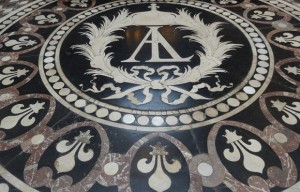
The central structure of the Val de Grâce complex was originally built as convent under the patronage of Anne of Austria in thanks for having given birth to a son, the future Louis XIV, after nearly 23 years of marriage. During the French Revolution, the convent was transformed into a military and teaching hospital, and it has remained so ever since.
Entrance the museum also gains access to the Baroque chapel of Val de Grace, one of the jewels of 17th-century religious architecture in Paris, as well as to the convent cloister. The museum occupies a portion of the cloister complex.
While covering much of the 19th and 20th centuries, the museum is particularly informative concerning the medical needs, care and developments of those wounded during the First World War. The war’s destructiveness brought forth the massive need for medical intervention to deal with the effects of bullets, shrapnel, explosion, mustard gas, horrific conditions in the trenches (rats, malaria, “sick” water), psychological trauma and the flu pandemic.
The State created the museum during that war to show the public the efforts that were being made on behalf of the “poilus,” as the French infantrymen were known. A major display (to be avoided perhaps by children for its grotesqueness) is wax models of the faces of the men were made unrecognizable by artillery wounds, known as “les gueules cassées” in French. The models—considered a medical success story for the army—show faces before and after maxilla-facial surgery, a field with more than ample patients to study and improve their techniques.
Musée du Service de Santé des Armées, 1 place Alphonse Laveran, 5th arrondissement. RER Port-Royal. Open Tues., Wed., Thurs., Sat., Sun. noon-6pm. Closed Jan. 1, Dee. 25 and the month of August. Entrance: 5€.

George Orwell fleeing a Paris hospital
If, after touring the hospital and medical heritage of Paris, you’d like good bedtime hospital horror story, read George Orwell’s essay How the Poor Die. Published in 1946, the brief essay is based on his experience in the public ward of Cochin Hospital (14th arr.), which he refers to as Hôpital X, where he spent two weeks when suffering from flu or pneumonia.
“During my first hour in the Hôpital X,” he wrote, “I had had a whole series of different and contradictory treatments, but this was misleading, for in general you got very little treatment at all, either good or bad, unless you were ill in some interesting and instructive way….As a non-paying patient, in the uniform nightshirt, you were primarily a specimen, a thing I did not resent but could never quite get used to…. It was not the only hospital I have fled from, but its gloom and bareness, its sickly smell and, above all, something in its mental atmosphere stand out in my memory as exceptional….For it was a hospital in which not the methods, perhaps, but something of the atmosphere of the nineteenth century had managed to survive, and therein lay its peculiar interest….”
Hopefully what will stand out in your memory as you visit these hospitals and museums is something more cheerful. And we can all toast: Santé!
Return to Part 1 of Hospital and Medical Heritage in Paris
© 2015/2016, Gary Lee Kraut. An earlier version of this article was originally published in the September 2015 issue of the British publication The Connexion.

